Samuel Thayer’s foraging books Nature’s Garden and The Forager’s Harvest are well loved by foragers, and his upcoming book, Incredible Wild Edibles, promises to be another great resource.
Thayer doesn’t cover the same wild edible foods in any of his books. Each book goes into great detail about a few dozen wild foods to forage, with new wild edibles in each book. This means if you’re looking for information about a specific wild food then it’s very helpful to know which book will cover it.
It turns out it’s really hard to find a list of the wild edibles covered in each of his books, though. Even Amazon doesn’t list the plants on the book’s pages (and there’s no “click to look inside” option) so once I finally found out which plants were covered in each book I figured I’d post the list here to help other foragers.
Here are the lists of wild foods covered in each of Thayer’s books.
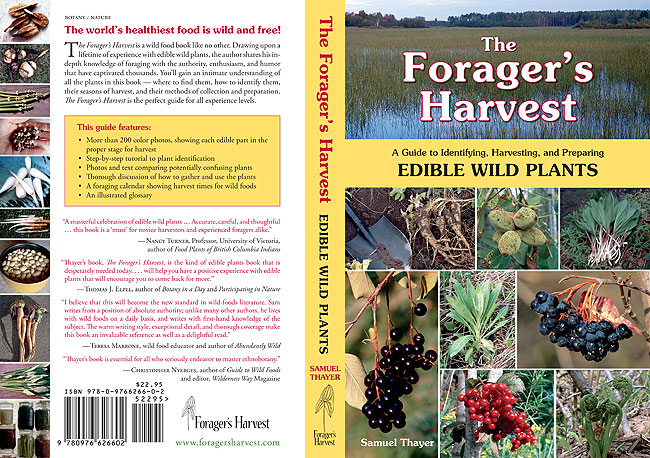
The Forager’s Harvest: A Guide to Identifying, Harvesting, and Preparing Edible Wild Plants (2006)
- ostrich fern
- cattail
- wapato
- wild rice
- wild leek
- smilax
- butternut
- siberian elm
- stinging nettle
- wood nettle
- sheep sorrel
- goosefoot or lamb’s quarters
- spring beauty
- marsh marigold
- swamp saxifrage
- serviceberry (a.k.a. juneberry or saskatoon)
- chokecherry
- pin cherry
- ground bean or hog peanut
- hopniss
- black locust
- sumac
- wild grape
- basswood
- evening primrose
- parsnip
- common milkweed
- virginia waterleaf
- nannyberry
- black haw
- highbush
- cranberry
- burdock
- thistle
Nature’s Garden: A Guide to Identifying, Harvesting, and Preparing Edible Wild Plants (2010)
- trout lily
- solomon’s seal
- false solomon’s seal
- american lotus
- mayapple
- hackberry
- walnut
- acorn
- hazelnut
- prickly pear
- amaranth
- passion flower
- toothwort
- garlic mustard
- blueberry
- huckleberry
- cranberry
- black huckleberry
- new jersey tea
- wild strawberry
- black cherry
- sand cherry
- wild plum
- aronia
- autumnberry
- bunchberry
- wood sorrel
- honewort
- wild carrot
- cow parsnip
- black nightshade
- bugleweed
- elderberry
- jerusalem-artichoke
- ox-eye daisy
- dandelions
- wild lettuce
- sow-thistle
- prenanthes
- chicory
- salsify
Honestly, I’m a little perplexed as to why Thayer chose to include some of these at the expense of other wild edibles that I consider much tastier and better to forage. For instance, I wouldn’t go out of my way to ever forage Virginia Waterleaf, which he included in the first book. While it’s certainly easy to find (especially in spring when little else is), I have yet to find a way to cook it where I’d want to eat it regularly unless it was a survival situation. He chose to include that at the expense of either acorns or elderberries (two of our family’s all time favorite foods to forage) until four years later? And no mulberries, crab apples, wild asparagus…. I kind of wonder if he purposely holds back some of the best wild foods for future volumes, which makes sense for book sales but not so much for the forager who wants one comprehensive guide to the best wild edible foods.
Samuel Thayer also has a book set to be released in November, Incredible Wild Edibles.
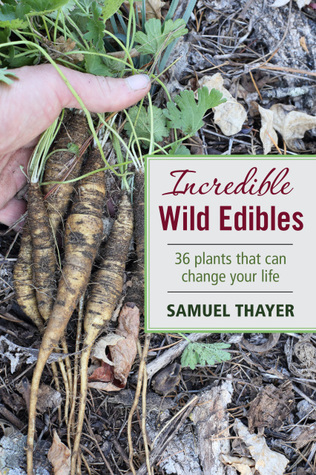
The book description promises that once again Thayer will not cover any wild edible plants he covered in previous books but once again it doesn’t list which wild edible plants it will cover. Thanks to a helpful reader who commented, we now know the list in this book too.
- Black Mustard
- Bladder Campion
- Sweet Flag (Calamus)
- Caraway
- Chickweed
- Chufa
- Creeping Bellflower
- Fennel
- Wild Garlic
- Gooseberry
- Hickory
- Hops
- Japanese Knotweed
- Kentucky Coffeetree
- Maple
- Miner’s Lettuce
- Mulberry
- Pawpaw
- Persimmon
- Poke
- Prairie Turnip
- Purple Poppy
- Mallow
- Purslane
- Quickweed
- Rose
- Sassafras
- Shepherd’s Purse
- Sochane
- Strawberry Spinach
- Sweetroot (Sweet Cicely, Aniseroot)
- Violet
- Watercress
- Water Parsnip
- Wild Radish
- Wintercress
I’m happy to see some of our family favorites on the list, like mulberries, violets, wild garlic and maples.
The description says:
Incredible Wild Edibles covers 36 of the best edible wild plants in North America: fruits, berries, nuts, shoots, leafy greens, root vegetables, culinary herbs, teas, and syrups that boast exceptional flavor and nutrition. The plants chosen represent every habitat and every region in North America, from the northern forests to the southwest deserts, from the largest cities to the wildest mountains. Rather than cover hundreds of species in brief accounts that leave the reader unsure of how to proceed, Samuel Thayer encourages readers to thoroughly learn one plant at a time. Each of these traditional foods has a rich culinary and cultural history―a wholesome past that is still relevant for our health and happiness today. The text is fully accessible to the novice, but remains botanically accurate and has the in-depth information that seasoned foragers crave.
Sharing the wisdom of a lifetime of daily foraging, the author answers all of the reader’s questions about each plant: How do I identify it? What might I confuse it with? Where can I find it? What part do I use, and when is it ready to be picked? How do I gather and prepare it? How can I be sure to harvest it responsibly? This discussion is accompanied by more than 350 color photos showing all the key features for identification, including potentially confusing species. Photos also depict the exact parts to use and the proper stage for collection. All of this is delivered in a familiar but authoritative tone, along with humorous anecdotes and insights from extensive real-life experience with each plant covered in the book.
Incredible Wild Edibles contains an index, bibliography, illustrated glossary, range maps, and foraging calendar. This third volume in Thayer’s Forager’s Harvest series has no overlap of the plants covered in the first two volumes.
If you’ve read the newest book, please share your feelings about it. I’d love to hear your thoughts.
**
This post contains affiliate links. Purchases made through our links earn us a small commission at no extra charge to you. Thanks!


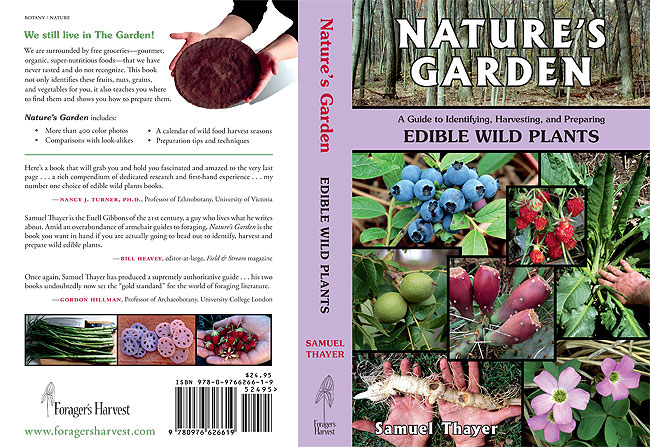

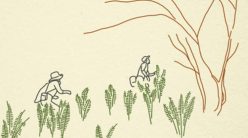
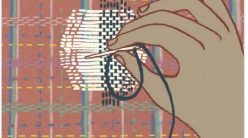
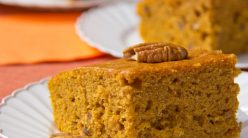
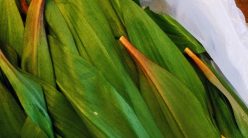
4 thoughts on “Which Wild Edible Plants Are Covered in Samuel Thayer’s Foraging Books?”
Melissa Price
(October 15, 2017 - 11:19 pm)The plants covered in Incredible Wild Edibles are:
Black Mustard, Bladder Campion, Sweet Flag (Calamus), Caraway, Chickweed, Chufa, Creeping Bellflower, Fennel, Wild Garlic, Gooseberry, Hickory, Hops, Japanese Knotweed, Kentucky Coffeetree, Maple, Miner’s Lettuce, Mulberry, Pawpaw, Persimmon, Poke, Prairie Turnip, Purple Poppy Mallow, Purslane, Quickweed, Rose, Sassafras, Shepherd’s Purse, Sochane, Strawberry Spinach, Sweetroot (Sweet Cicely, Aniseroot), Violet, Watercress, Water Parsnip, Wild Radishes, Wintercress
Alicia Bayer
(October 16, 2017 - 2:36 pm)Awesome! Thanks so much! I’ll update the post with the list.
Rodale Pulls Foraging Cookbook That Gives Dangerous Information on Elderberries, Acorns and Mushrooms - A Magical Life
(August 14, 2018 - 7:28 pm)[…] new book, The Fruit Forager’s Companion (my review is here) and I’m hoping to pick up all of Samuel Thayer’s books. I’ll try to compile a list of my other favorites soon. We own about 20 or 30 foraging […]
Pineapple Nettle Smoothies - A Magical Life
(August 2, 2019 - 5:07 pm)[…] a ton of information about stinging nettles in his famous foraging book, Nature’s Harvest. Here’s a list of all the wild edibles that he features in depth in each of his wonderful foraging […]